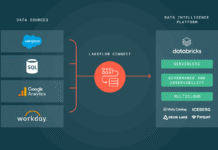Table of Contents
Mastering Databricks Engineering Concepts
Data engineering on the Databricks platform is powerful, but several key concepts can be tricky. Misunderstanding the nuances of Delta Lake transactions, pipeline orchestration, or resource management can lead to inefficient, unreliable, and costly data operations. This post dives deep into several core topics that frequently challenge engineers, providing detailed explanations and practical examples to solidify your understanding.
From Fragile Files to Reliable Tables: The Delta Lake Advantage
A common starting point for data pipelines is a collection of files in cloud storage. However, relying directly on these files introduces fragility.
The Challenge with External Parquet Files
When you create a table on top of a directory of Parquet files, Spark caches the file list for performance. This creates a problem: if an external process adds new files to that directory, Spark’s cache becomes stale and your queries will not return the new data.
Let’s imagine a scenario where we have a table defined over a directory of customer data.
-- This table points to a directory of Parquet files
CREATE TABLE customers_parquet
(id INT, name STRING)
USING PARQUET
LOCATION '/mnt/landing/customers_parquet';An external process uploads a new file, part-0002.parquet, into the /mnt/landing/customers_parquet directory. If you query the table immediately, the new customers in that file will be missing.
-- This query will not see the new data due to the stale metadata cache
SELECT COUNT(*) FROM customers_parquet;The manual workaround is to force a cache invalidation for the table.
-- This command forces Spark to re-scan the directory
REFRESH TABLE customers_parquet;
-- Now, the query will return the correct, updated count
SELECT COUNT(*) FROM customers_parquet;This is a reactive, manual step that makes pipelines brittle and hard to manage.
The Delta Lake Solution: The Transaction Log
Delta Lake solves this problem fundamentally by introducing a transaction log, stored in a _delta_log subdirectory alongside the data files. This log is the single source of truth for which files constitute the table at any given version.
When you use Delta Lake, you never need to manually refresh a table.
-- Creating a Delta table is the modern default
CREATE TABLE customers_delta
(id INT, name STRING)
USING DELTA
LOCATION '/mnt/data/customers_delta';
-- Any write operation automatically updates the transaction log
INSERT INTO customers_delta VALUES (101, 'Charlie');When you run a query, Spark consults the transaction log to get the correct list of current files, guaranteeing that you always see the most recent, consistent state of the data.
Preserving History: Understanding Delta Lake Transactions
How you update data in Delta Lake has profound implications for auditing and data recovery. The distinction between overwriting and recreating a table is critical.
The Pitfall of DROP and CREATE
A naive approach to replacing a table’s data is to drop the table and recreate it with the new data.
-- This permanently deletes the table, its data, and its entire history
DROP TABLE IF EXISTS daily_sales;
-- This creates a brand new table with a fresh history
CREATE TABLE daily_sales AS SELECT ...;This action is destructive. It erases the table’s entire version history, making it impossible to audit past changes or recover from accidental data loss using Delta Lake’s Time Travel feature. Running DESCRIBE HISTORY daily_sales would show only a single entry for the table’s creation.
The Power of INSERT OVERWRITE
The correct, idiomatic way to replace data in a Delta table is with INSERT OVERWRITE.
-- This is an atomic operation that creates a new version of the table
INSERT OVERWRITE daily_sales
SELECT ... FROM new_daily_data;This operation is far superior for several reasons:
- Atomicity: The overwrite is an all-or-nothing transaction. The table is never in a partially loaded or empty state for concurrent readers.
- History Preservation: This command does not delete old versions. Instead, it creates a new version in the transaction log.
After an overwrite, you can inspect the table’s rich history.
DESCRIBE HISTORY daily_sales;This command would now show multiple versions, allowing you to query previous states of the table using Time Travel, a powerful feature for debugging and auditing.
-- Query the table as it existed before the most recent overwrite
SELECT * FROM daily_sales VERSION AS OF 1;Orchestrating Data Flows with Finesse
The Medallion Architecture provides a clear pattern for structuring data pipelines, moving data from a raw state to a highly curated and valuable state.
The Medallion Architecture: A Quick Primer
This architecture organizes data into three logical layers: Bronze, Silver, and Gold.
Code snippet
+-----------------+ +-----------------+ +----------------+
| Bronze Table |----->| Silver Table |----->| Gold Table |
| (Raw, Unaltered)| | (Clean, Enriched| | (Aggregated, |
| | | Validated) | | Business-Ready|
+-----------------+ +-----------------+ +----------------+Reading from Bronze: The Cleaning and Enrichment Phase
A job that reads from a Bronze table has the goal of producing a Silver table. Its responsibilities are to clean, validate, filter, and enrich the raw data.
Example: Imagine a Bronze table iot_raw_events that ingests raw JSON payloads from sensors.
-- Example job reading from Bronze to create Silver
CREATE OR REPLACE TABLE iot_silver_events AS
SELECT
CAST(payload:device_id AS LONG) as device_id,
payload:event_type AS event_type,
CAST(payload:timestamp AS TIMESTAMP) as event_timestamp,
payload:data:temperature AS temperature
FROM iot_raw_events
WHERE payload:device_id IS NOT NULL; -- Filter malformed recordsThis job uses the Bronze table as its source to create a clean, strongly-typed Silver table.
Reading from Silver: The Aggregation Phase
A job that reads from a Silver table aims to create a Gold table. It takes the clean, validated data and aggregates it into business-level views, summaries, or features for machine learning.
Example: Using our iot_silver_events table, we can create a Gold table with daily average temperatures per device.
-- Example job reading from Silver to create Gold
CREATE OR REPLACE TABLE daily_device_summary AS
SELECT
device_id,
DATE(event_timestamp) as report_date,
AVG(temperature) as avg_temperature,
COUNT(*) as event_count
FROM iot_silver_events
GROUP BY device_id, DATE(event_timestamp);This job uses the Silver table as its source to produce valuable, aggregated data ready for reporting.
Advanced Pipelines and Operations
For more complex requirements, Databricks provides higher-level tools like Delta Live Tables and fine-grained operational controls.
Beyond Manual Orchestration: Delta Live Tables
In a standard pipeline, you are responsible for defining the execution order of your notebooks. Delta Live Tables (DLT) abstracts this away with a declarative approach. You define your datasets, and DLT automatically infers the dependencies to build the execution graph.
Example: Consider two DLT definitions in SQL.
-- Bronze DLT Table
CREATE STREAMING LIVE TABLE bronze_raw_data
COMMENT "Raw data ingested from cloud storage"
AS SELECT * FROM cloud_files("/path/to/raw/data", "json");
-- Silver DLT Table
CREATE STREAMING LIVE TABLE silver_cleaned_data
COMMENT "Cleaned and validated data"
AS SELECT
id,
CAST(timestamp as TIMESTAMP) as timestamp,
payload
FROM STREAM(live.bronze_raw_data)
WHERE id IS NOT NULL;By referencing live.bronze_raw_data, the second definition tells DLT that it depends on the first one. DLT will automatically ensure bronze_raw_data is processed before silver_cleaned_data without you needing to define explicit task dependencies.
Guarding Your Data: DLT Expectations
DLT allows you to define data quality constraints directly in your pipeline. The EXPECT clause is used to assert rules about your data.
By default, an expectation does not stop the pipeline or drop records. It logs the violation and allows the data to proceed, acting as a data quality monitoring tool.
Example:
CONSTRAINT valid_timestamp EXPECT (timestamp > ‘2020-01-01’)
This constraint checks if the timestamp is valid. If a record with timestamp = '1999-12-31' arrives, it will be loaded into the target table, but an entry will be made in the DLT event log noting that a record failed the valid_timestamp expectation.
You can alter this behavior with an ON VIOLATION clause.
| Clause | Behavior |
| (No clause – Default) | ✅ Load the record, 📝 Log the violation. |
ON VIOLATION DROP ROW | ❌ Do not load the record, 📝 Log the violation. |
ON VIOLATION FAIL UPDATE | 💥 Stop the pipeline entirely, 📝 Log the violation. |
Building Resilient Jobs: Granular Retries
When a multi-task job fails, it’s often just one unreliable task that is the cause. Databricks Jobs allow you to set retry policies at the individual task level. This is far more efficient than retrying the entire job, which would waste compute resources by re-running tasks that succeeded on the first attempt. This granular control is configured directly in the Jobs UI when defining your workflow.
Managing and Monitoring Your Lakehouse
Effective data engineering goes beyond writing code; it includes managing operations and performance.
Jobs as Code: Versioning Your Operations
A Databricks Job has two key components:
- The Code: The notebook or script that executes. This should be versioned in Git using Databricks Repos.
- The Configuration: The settings for the job, including its schedule, cluster definition, parameters, and retry policies.
This configuration can be versioned by exporting it as a JSON file from the Jobs UI. This allows you to practice “Jobs as Code,” where your operational setup is stored and versioned alongside your business logic.
Example JSON Snippet:
JSON
{
"name": "My_Daily_ETL_Job",
"email_notifications": { ... },
"tasks": [ ... ],
"schedule": {
"quartz_cron_expression": "0 0 4 * * ?",
"timezone_id": "UTC",
"pause_status": "UNPAUSED"
},
"new_cluster": {
"spark_version": "14.3.x-scala2.12",
"node_type_id": "i3.xlarge",
"num_workers": 10
}
}Sizing Your SQL Warehouse: Performance vs. Concurrency
When a Databricks SQL Warehouse (formerly SQL Endpoint) is slow, it’s crucial to diagnose the right problem.
| Symptom | Problem | Solution |
| A single user runs queries sequentially, and every query is slow. | Under-provisioned: The cluster is too small for the query’s complexity. | Increase the Cluster Size (e.g., Small -> Medium). |
| Many users run queries concurrently, and they start to queue and slow down. | Concurrency Bottleneck: The warehouse cannot handle the number of parallel requests. | Increase the Max Clusters setting for multi-cluster load balancing. |
Choosing the right solution is key. Increasing the scaling range won’t help a single, slow query, and increasing the cluster size may be overkill if the problem is just handling more users.
Alerting on Insights, Not Dashboards
Databricks SQL provides a powerful alerting feature, but it’s important to understand where it fits architecturally.
- Queries fetch and process data.
- Dashboards visualize the results of queries.
- Alerts monitor the data results from queries.
The correct approach is to define an alert directly on the query that produces the metric you care about.
Example: You want to be notified if your application logs more than 100 errors in an hour.
- Write the Query:SQL
SELECT COUNT(*) AS error_count FROM application_logs WHERE level = 'ERROR' AND timestamp > now() - INTERVAL 1 HOUR; - Create the Alert: In the SQL query editor, create an alert based on this query. Set the trigger condition to
Value column: error_count,Operator: >, andThreshold: 100. - Set Schedule: Schedule the alert to run every hour.
This alert is tied to the data itself. Attaching it to a dashboard is incorrect, as the dashboard is just a visualization layer. The alert’s logic lives with the query.



